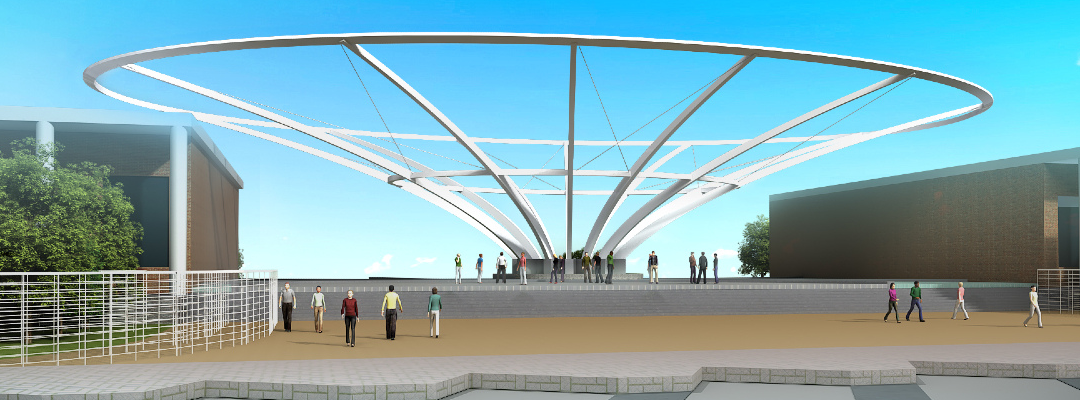Tensile structures have become a popular choice for public spaces due to their ability to seamlessly combine functionality with architectural beauty. Whether used for shading, protection, or creating iconic landmarks, these structures strike a perfect balance between purpose and aesthetics, enhancing the usability and visual appeal of public areas.
Purpose of Tensile Structures in Public Spaces
- Shelter and Protection
- Weather Resistance: Provides protection from rain, UV rays, and wind, making public spaces more usable year-round.
- Durability: Tensile materials like PTFE, PVC, and ETFE are designed to withstand harsh environmental conditions.
- Space Optimization
- Large Spans: Tensile structures cover vast areas without internal columns, offering unobstructed spaces for events, gatherings, and recreational activities.
- Versatile Applications: Ideal for walkways, amphitheaters, playgrounds, and marketplaces.
- Functional Flexibility
- Multi-Use Design: Structures can serve dual purposes, such as shading during the day and lighting displays at night.
- Temporary or Permanent: Suitable for both long-term installations and temporary setups, such as event tents or pavilions.
- Cost-Effective Solution
- Efficient Construction: Lightweight materials and prefabricated components reduce installation time and costs.
- Low Maintenance: Resistant to corrosion and wear, minimizing upkeep expenses.
Aesthetic Appeal of Tensile Structures in Public Spaces
- Creative and Modern Designs
- Dynamic Shapes: Tensile structures can be designed in various forms, such as sails, domes, and cones, creating visually stunning elements in public spaces.
- Customizable Appearance: Available in a range of colors, textures, and patterns to match the surrounding environment or branding.
- Iconic Landmarks
- Unique Identity: Bold and innovative designs often become symbolic landmarks, attracting visitors and enhancing community pride.
- Cultural Integration: Tensile structures can incorporate local architectural styles and motifs, blending tradition with modernity.
- Light and Transparency
- Natural Lighting: Translucent materials allow diffused natural light, creating bright and welcoming spaces.
- Nighttime Aesthetics: Integration with LED lighting and projections transforms tensile structures into captivating nighttime features.
- Harmonious Integration
- Blending with Nature: Organic shapes and lightweight designs complement natural landscapes, preserving the beauty of parks and open spaces.
- Architectural Synergy: Tensile structures can seamlessly integrate with surrounding buildings and infrastructure.
How Purpose and Aesthetics Are Balanced
- Collaborative Design Process
- Architects, engineers, and designers work together to ensure the structure meets both functional and aesthetic goals.
- Advanced tools like parametric modeling and 3D visualization aid in achieving a harmonious balance.
- Material Selection
- High-performance fabrics are chosen for their durability, translucency, and aesthetic qualities.
- Coated membranes enhance weather resistance while maintaining a sleek appearance.
- Structural Efficiency
- Lightweight designs reduce material usage and construction costs without compromising visual impact.
- Use of minimal supports ensures open spaces and unobstructed views.
- Adaptability
- Modular designs allow for expansion, reconfiguration, or relocation to meet evolving needs while maintaining visual harmony.
- Flexible designs accommodate both day-to-day functionality and special events.
Applications of Tensile Structures in Public Spaces
- Parks and Recreation Areas
- Shaded seating areas, picnic zones, and playgrounds.
- Enhances comfort while blending with natural surroundings.
- Amphitheaters and Event Venues
- Canopies for outdoor performances and gatherings.
- Iconic designs that draw visitors and add cultural value.
- Transportation Hubs
- Covered walkways, bus stops, and train station roofs.
- Combines weather protection with a modern aesthetic.
- Markets and Commercial Spaces
- Shade for open-air markets, food courts, and shopping streets.
- Creates vibrant and attractive spaces for commerce.
- Landmark Structures
- Focal points in urban landscapes, such as tensile pavilions or sculptures.
- Serves as a photo-friendly attraction and a symbol of innovation.
Examples of Tensile Structures Balancing Purpose and Aesthetics
- The Millennium Dome (London, UK): A tensile structure that combines large-scale functionality with iconic design.
- The Denver International Airport Canopy (USA): Aesthetic white peaks resembling the Rocky Mountains, offering both protection and visual identity.
- The Khan Shatyr Entertainment Center (Kazakhstan): A climate-controlled tensile structure that serves as a multifunctional public space and architectural marvel.
Advantages of Balancing Purpose and Aesthetics
- Enhanced Usability: Makes public spaces more functional and inviting for diverse activities.
- Community Engagement: Attracts visitors and encourages community interaction.
- Economic Boost: Iconic designs increase tourism and local business opportunities.
- Sustainability: Lightweight, recyclable materials support eco-friendly construction practices.

